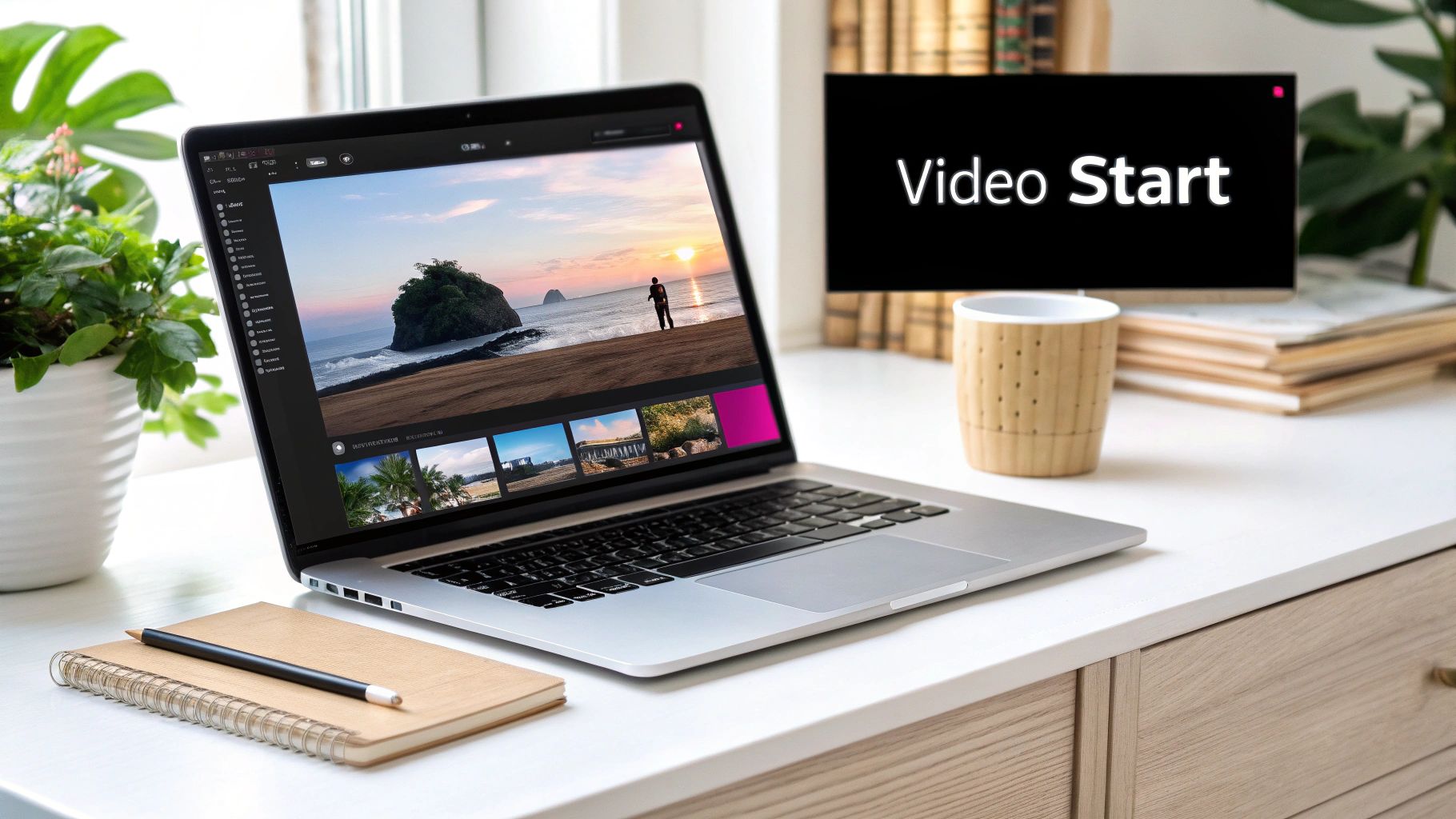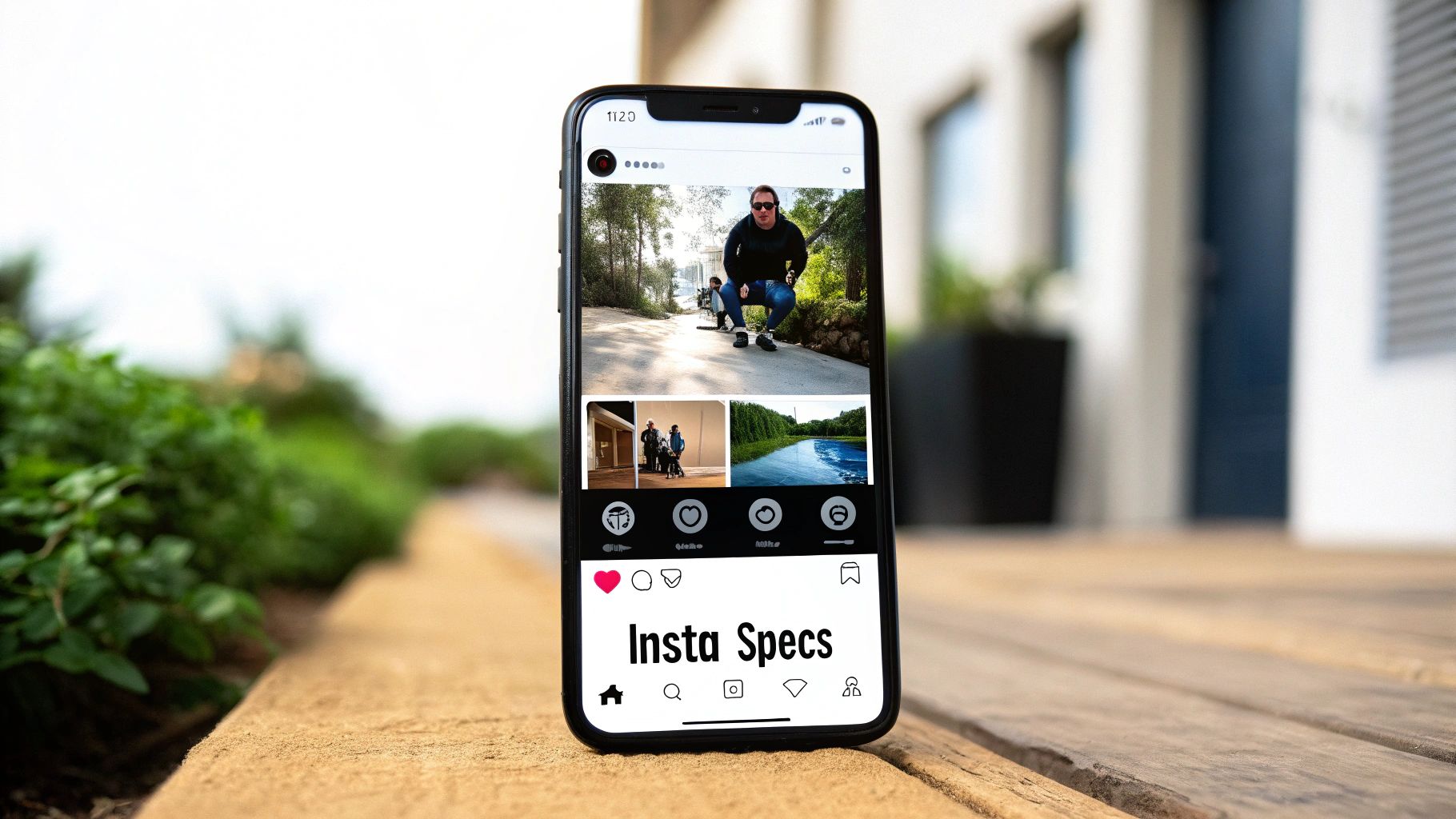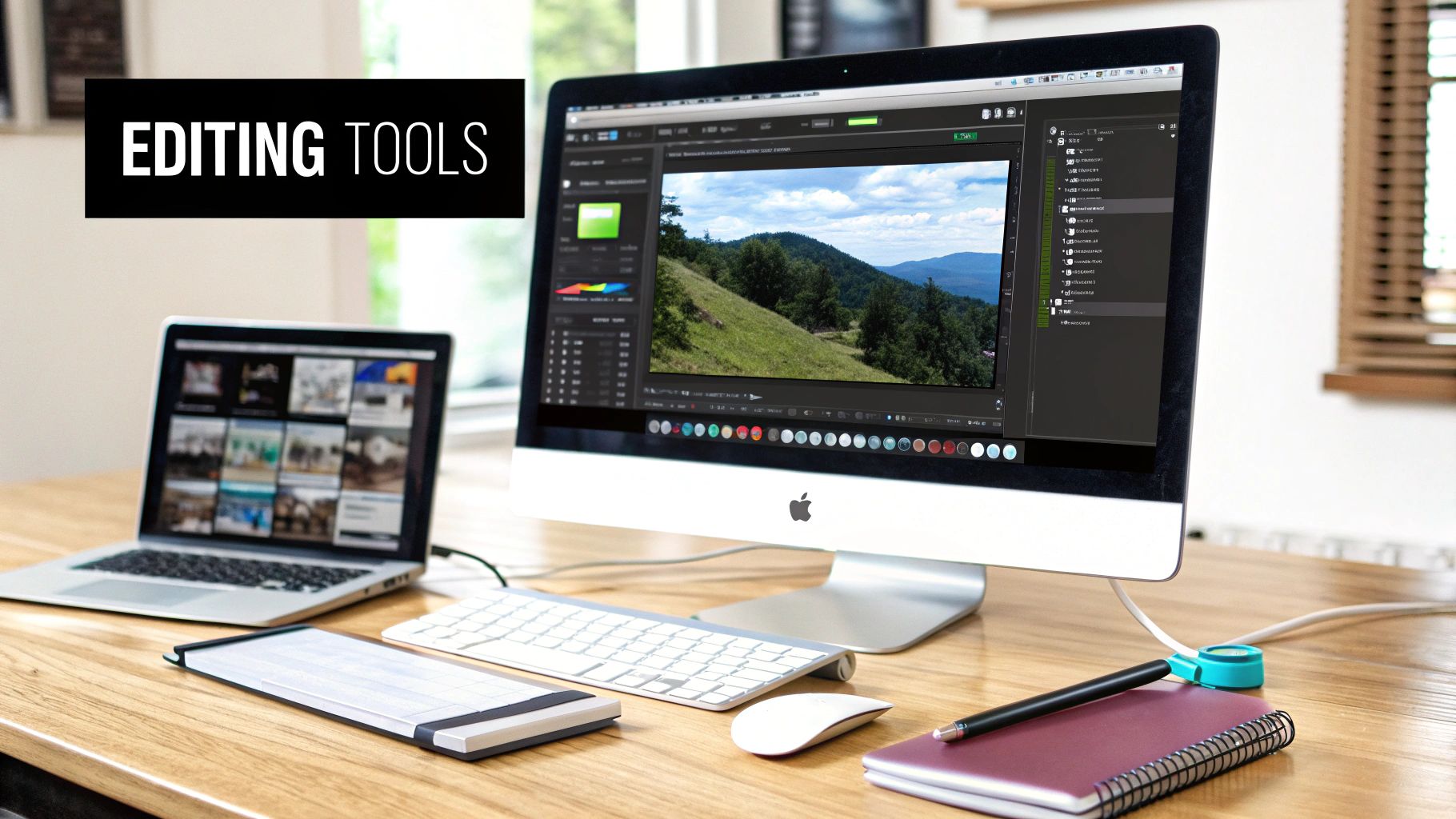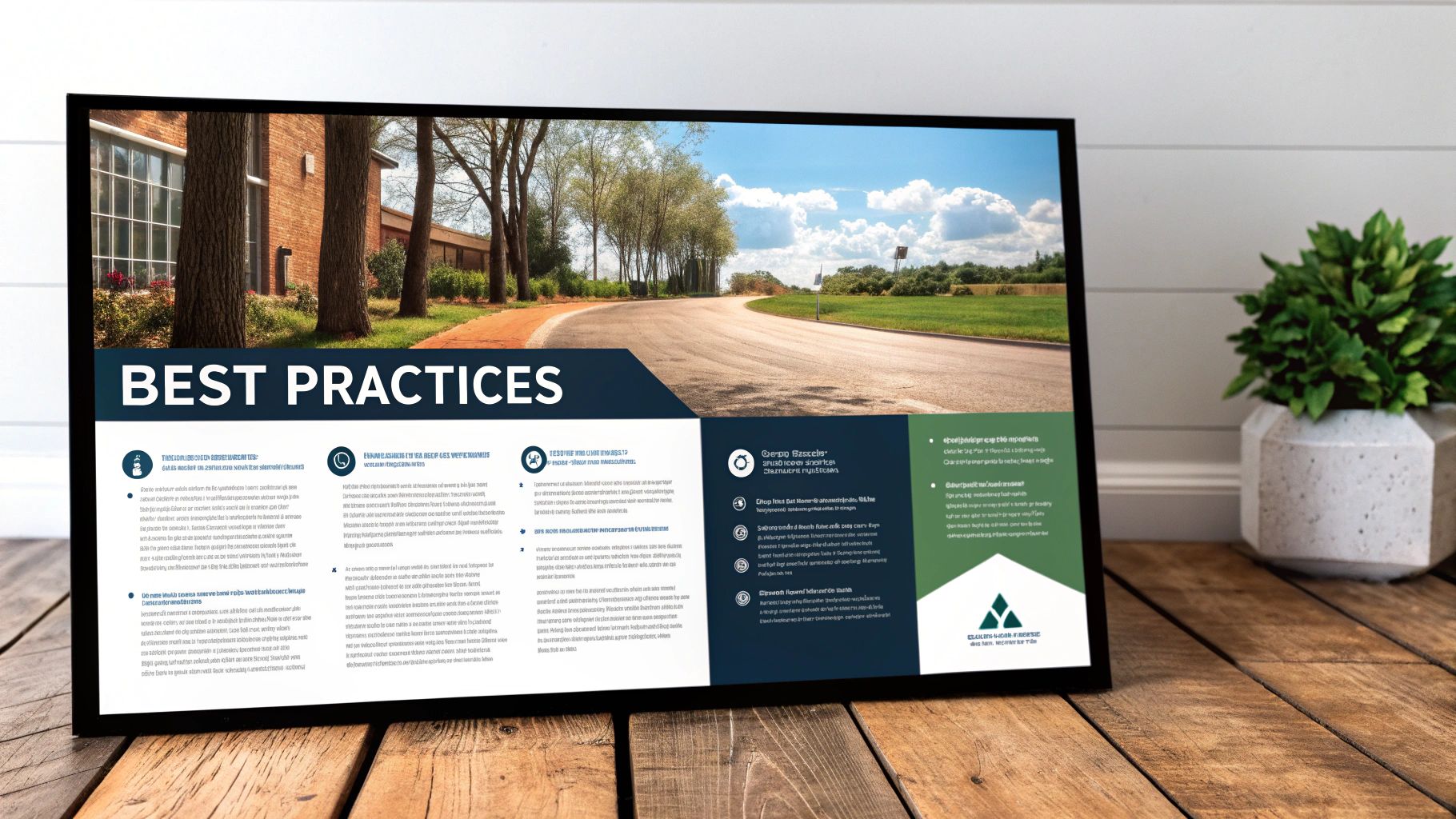Compress Videos for Instagram: Easy Tips
Why Video Compression Makes or Breaks Your Instagram Strategy
Instagram, with its enormous user base, presents a significant challenge for content creators. The platform offers tremendous potential, but technical hurdles can easily limit your reach. This is where video compression becomes essential, not just a technical detail, but a core component of a successful Instagram strategy. Effective compression ensures your videos load quickly and look great, two factors that heavily influence how viewers engage with your content.
Imagine scrolling through Instagram and coming across a video that takes forever to load. Chances are, you'd keep scrolling. This illustrates the importance of fast loading times, a direct result of proper video compression. A well-compressed video keeps viewers engaged and encourages them to watch to the end, improving your content's overall performance.
Maintaining visual quality is also crucial for your brand image. Blurry or pixelated videos reflect poorly on your brand. Compression needs to strike a balance between reducing file size and preserving quality. This balance directly impacts how your audience perceives your brand.

Compressing videos for Instagram means making files smaller while keeping them looking good, a key step considering the platform’s massive reach. Instagram boasts over 2.5 billion active users, and video content makes up over 80% of its traffic. To handle this volume, Instagram utilizes advanced encoding techniques like AV1 and H.264. Learn more about how Instagram handles video compression here. This highlights the complex technology behind something as seemingly simple as uploading a video.
Why Instagram's Algorithm Loves Compressed Videos
Beyond the viewer experience, Instagram's algorithm favors well-compressed videos. The algorithm prioritizes content that keeps users engaged. Faster loading times and high-quality visuals contribute to better engagement metrics, which signals to the algorithm that your content is valuable. This can lead to increased visibility, potentially landing your videos on the Explore page and reaching a wider audience.
The Competitive Edge of Compression
Many creators struggle with reach despite creating high-quality content. The missing element is often a solid understanding of video compression. Mastering compression gives you a competitive advantage. Your videos load faster, look better, and perform better within the algorithm, resulting in more views, likes, and comments. This translates to increased brand awareness, stronger audience connections, and more growth opportunities on Instagram. Think of it as unlocking your content's full potential on a competitive platform.
Instagram's Video Requirements: What You Actually Need to Know
Understanding Instagram's technical specifications is crucial for maximizing your content's reach. This guide breaks down the requirements for different video formats, from in-feed posts and Stories to Reels, explaining why these specifications matter and how they affect your audience.
Why Video Specs Matter on Instagram
Instagram's limits on video dimensions, length, and file size directly influence how people view your content. Because Instagram is primarily a mobile platform, large files can mean slow loading times, especially on mobile networks. Viewers might scroll past before your video even starts. Consistent aspect ratios and resolutions also create a better viewing experience across the platform.
Understanding Resolution, Aspect Ratio, and Length
Let's look at the practical side of Instagram's video requirements. While Instagram supports various resolutions, using the recommended settings ensures your videos look their best.
-
In-Feed Videos: Aim for 1080 x 1080 pixels (square) or 1080 x 1920 pixels (vertical). Keep videos between 3 and 60 seconds long.
-
Stories: Although Stories can be up to 1080 x 1920 pixels, Instagram crops them. Design with a 9:16 aspect ratio in mind. Individual story segments are limited to 15 seconds, but longer videos are automatically divided into segments.
-
Reels: Similar to Stories, use a 9:16 aspect ratio and a resolution up to 1080 x 1920 pixels. Reels currently allow up to 90 seconds of video.
Keep in mind that Instagram uses compression, which can sometimes affect video quality. Careful initial compression is vital for maintaining your video's visual integrity. For a deeper dive into social media compression, check out this helpful resource: How to master social media compression.
Instagram's Compression Explained
Instagram’s video compression aligns with standard industry practices. The platform supports formats like MP4 and MOV, but MP4 is generally recommended for its balance of quality and file size. Instagram suggests using the H.264 video codec and AAC audio codec, with a bitrate of 3,500 kbps and a frame rate of 30 fps. These settings help maintain quality after compression, ensuring your videos look sharp on different devices. Learn more about this topic here. This ensures videos maintain quality across varying internet connection speeds.
Adjusting Compression for Different Video Types
Effective creators adjust their compression based on the type of video. For Reels, with more movement, a higher bitrate might be better, even with a larger file size. For static in-feed posts, a lower bitrate might be acceptable. Experiment to find the right balance between quality and file size for each format. Understanding this allows for efficient video compression on Instagram while retaining a professional appearance.

The following table summarizes the key technical specifications for Instagram videos:
Instagram Video Format Requirements by Type
A comprehensive comparison of technical requirements for different Instagram video formats
| Format Type | Max Duration | Aspect Ratio | Recommended Resolution | Max File Size |
|---|---|---|---|---|
| In-Feed Video | 60 seconds | 1:1 (square) or 9:16 (vertical) | 1080 x 1080 (square) or 1080 x 1920 (vertical) | Varies based on duration |
| Story | 15 seconds per segment (up to 60 seconds total) | 9:16 | 1080 x 1920 | Varies based on duration |
| Reel | 90 Seconds | 9:16 | 1080 x 1920 | Varies based on duration |
This table provides a quick reference for the essential technical details of each Instagram video format. Remembering these specifications helps create high-quality videos optimized for the platform.
Tools That Actually Work: Compression Solutions for Creators
Finding the right video compression tool can feel overwhelming. So many options exist, each claiming to be the best. This section bypasses the marketing jargon and highlights tools that truly deliver, balancing reduced file size with excellent video quality.
Free Tools: Surprisingly Powerful Options
For budget-conscious creators, free tools can be surprisingly effective when compressing videos for Instagram. HandBrake, an open-source favorite, provides extensive customization options. While it has a learning curve, the control it offers appeals to experienced creators. For more compression tips, check out this helpful resource: How to master FFmpeg and an easier alternative. VLC, a versatile media player, also handles compression. Its simplicity is perfect for quick compressions without complex adjustments.
Paid Tools: Investing in Efficiency and Quality
If high-quality Instagram content is your priority, investing in a paid compression tool can be beneficial. Compresto, designed for macOS, combines an intuitive interface with powerful compression algorithms. It's particularly useful for creators working with large video files. Features like folder monitoring and a Raycast extension streamline your workflow, saving valuable time. Adobe Media Encoder, part of the Adobe Creative Cloud suite, offers advanced features and integrates smoothly with other Adobe applications. It's a natural fit for creators already using Premiere Pro or After Effects.
Online Tools: Quick and Convenient Compression
Online video compressors offer a convenient way to reduce file sizes without software installation. Riverside's Video Compressor, for example, provides a simple drag-and-drop interface with adjustable compression levels. It's ideal for quick tweaks before uploading to Instagram. Clideo also offers various online video tools, including a compressor supporting multiple file formats.
Comparing Compression Tools
The best tool depends on your individual needs and budget. The following table compares popular options, highlighting key features and pricing:
To help you choose the right video compression tool, we've compiled a comparison table of popular options. This table breaks down the key features, pricing, and platform compatibility of each tool to help you make an informed decision.
Top Video Compression Tools Comparison
Comparison of popular video compression tools for Instagram content creators
| Tool Name | Platform | Price | Ease of Use | Quality Retention | Key Features |
|---|---|---|---|---|---|
| HandBrake | Mac, Windows, Linux | Free | Advanced | Excellent | Customizable settings, open-source |
| VLC | Mac, Windows, Linux | Free | Beginner | Good | Simple interface, versatile media player |
| Compresto | macOS | Paid | Beginner | Excellent | Folder monitoring, Raycast extension |
| Adobe Media Encoder | Mac, Windows | Paid (part of Creative Cloud) | Advanced | Excellent | Advanced features, Adobe integration |
| Riverside Video Compressor | Online | Free | Beginner | Good | Drag-and-drop interface, adjustable compression |
| Clideo | Online | Free (with limitations) | Beginner | Good | Multiple file format support |
As you can see, there's a variety of tools available, each with its own strengths. Consider your budget, technical skills, and desired quality level when making your selection.
Optimizing Your Compression Workflow
Regardless of your chosen tool, understanding compression settings is crucial for optimal results. Experiment with different bitrates, resolutions, and codecs to find the perfect balance between file size and quality. Consider your content type. Fast-paced action videos may need a higher bitrate to avoid blurring, while static images or slow-motion videos can handle lower bitrates. This ensures quick Instagram loading while maintaining a professional look. Testing compressed videos on various devices before uploading confirms your content looks great for everyone. With the right tools and techniques, you can overcome Instagram's compression challenges and showcase your best work.

From Raw Footage to Perfect Upload: Your Compression Workflow
Transforming raw footage into polished, Instagram-ready videos requires a well-defined workflow. This section guides you through each stage, from initial recording considerations to final checks before uploading. This approach will significantly impact your final video quality and efficiency.
Pre-Production Planning: Setting the Stage for Success
Before even hitting the record button, successful creators know that pre-production planning is key. Thinking about compression at this stage can drastically improve your final product.
- Controlled Lighting: Consistent lighting minimizes noise, which in turn improves compression. Think of it as decluttering before you organize – it makes the entire process smoother.
- Stable Shots: Shaky footage increases the data needed to represent motion, making compression less effective. Invest in a tripod or gimbal to keep your shots steady and professional.
- Clean Backgrounds: Simple backgrounds are much easier to compress than complex ones. Fewer details mean less data to encode, resulting in smaller file sizes.
These simple pre-production steps lay the groundwork for efficient and high-quality compression.
Shooting Techniques: Optimizing Footage from the Start
Even during filming, certain techniques can significantly impact your compression workflow. Making informed decisions about resolution and frame rate can make a big difference.
- Optimal Resolution: While 4K might be tempting, 1080p is generally sufficient for Instagram. This resolution strikes a good balance between quality and manageable file sizes.
- Consistent Frame Rate: Sticking to standard frame rates, like 24fps or 30fps, ensures consistency and reduces the processing load during compression.
- Minimize Motion Blur: Excessive motion blur adds complexity to the video, making it harder to compress effectively. Control motion blur by adjusting your shutter speed.
By optimizing your footage during filming, you're setting yourself up for a smoother post-production process.
Post-Production Compression: Finding the Sweet Spot

Now for the heart of the process: the actual compression. Choose your compression software and follow these key steps.
- Choose the Right Format: MP4 with the H.264 codec is the gold standard for online video, offering excellent compatibility and efficient compression.
- Adjust Bitrate and Resolution: Experiment to find the best balance between file size and quality. High-motion content may need a higher bitrate, while static shots can handle a lower one.
- Two-Pass Encoding: If your software supports it, two-pass encoding can improve quality at the same file size. The first pass analyzes the video, and the second pass optimizes compression based on that analysis.
Common compression issues, such as color shifting, audio desynchronization, and quality degradation, often stem from incorrect settings. Double-check your video and audio settings within your chosen software to avoid these pitfalls. For instance, inaccurate color space settings can result in color shifts after compression.
Instagram's own compression algorithms also play a role. Understanding how these algorithms work can help you optimize your videos further. Instagram has made significant strides in optimizing its video encoding process. They've achieved a remarkable 94% reduction in compute time for standard video encodes by efficiently reusing encoding files for both progressive and adaptive bitrate streaming. You can learn more about these optimizations here.
Final Checks and Upload: Ensuring Seamless Delivery
Before uploading, preview your compressed video on different devices. This ensures your video looks good across various screen sizes and internet connection speeds. Look for any remaining pixelation, audio issues, or color distortions. Once you’re satisfied, upload your video to Instagram. Continue monitoring its performance after posting. If any quality issues appear, revisit your compression workflow and adjust accordingly.
By following this complete workflow, from pre-production to final checks, you can effectively compress videos for Instagram, maximizing quality and viewer engagement while meeting Instagram's technical requirements.
Pro-Level Compression Techniques That Outperform the Basics
Creating professional videos for Instagram requires more than just basic compression. This section dives into advanced techniques that elevate your content beyond amateur status. Properly using these methods can dramatically improve your videos' visual quality and overall impact.
Variable Bitrate Encoding: Adapting to the Scene
Variable Bitrate Encoding (VBR) dynamically adjusts the bitrate according to the complexity of what's happening on screen. Imagine a video that shifts between fast-paced action and slower dialogue. VBR increases the bitrate during the action to capture every detail, then lowers it during calmer moments to conserve file size. This intelligent optimization lets you compress for Instagram without sacrificing quality.
Multi-Pass Compression: A Two-Step Approach for Quality
Multi-Pass Compression analyzes your video in stages. The first pass assesses the content, and subsequent passes optimize the compression based on this initial analysis. While this takes a bit longer, the improvement in quality is significant. Think of it like a sculptor refining their work; the first pass shapes the form, while the following passes perfect the details. Multi-pass compression ensures your video looks its best, even within Instagram's compression limitations.
Strategic Keyframe Placement: Enhancing Quality in Motion
Keyframes are complete frames within a video, serving as anchors for the frames that follow. Strategic keyframe placement helps use data efficiently, resulting in better quality, especially in motion. This is particularly crucial for videos with lots of movement or scene changes. Proper keyframe placement prevents blur and creates a smoother viewing experience, which is vital on a platform like Instagram where video quality matters.
Adapting to Content Style: Compression for Every Situation
Experienced creators tailor their compression strategy to the specific type of video. Animated videos, with their sharp lines and bold colors, need different settings than dialogue-driven videos where audio clarity is paramount. Recognizing these differences lets you optimize each video individually. For example, detailed animation might benefit from a higher bitrate, even if the file size increases. Conversely, a dialogue-focused video might prioritize audio quality, allowing for a lower video bitrate.
Workflow Optimizations: Saving Time Without Sacrificing Quality
Efficient workflows are key for consistent, high-quality content. Creating custom presets in your compression tool, such as Compresto, maintains consistency. These presets act like personalized recipes for your Instagram videos, ensuring consistent quality. They can be further optimized for different video types, like Reels or Stories, making your workflow even smoother. Features like Compresto’s folder monitoring automate compression, allowing you to focus on your creative work. This automation is a game-changer for busy creators who value both efficiency and quality. By understanding and applying these pro-level compression techniques, you’ll noticeably improve the quality and performance of your Instagram videos.
Compression Mistakes Costing You Views and Engagement
Even experienced creators sometimes make compression errors that hurt their content's performance. Let's look at some common compression problems that can turn viewers away and even trigger Instagram's quality filters.
The Silent Killers of Video Quality
Small issues like incorrect color space settings or bad audio compression can greatly impact how long viewers watch your videos. A video with the wrong color space might look washed out or too bright after Instagram compresses it, making it less appealing. Poor audio compression can lead to distorted or quiet sound, causing viewers to click away. These small technical details can significantly affect a viewer's overall impression.
This means a well-made video can still underperform if the compression isn't handled correctly. Imagine putting hours into creating a beautiful video, only to have it look pixelated or distorted on Instagram. All that effort is wasted if the final compression step ruins the quality. Understanding compression is key to preventing this.
Decoding Instagram's Algorithm Penalties
Some compression choices can lead to penalties from Instagram's algorithm. Instagram prefers videos that load quickly and play smoothly. A high bitrate video, while visually impressive, can take a long time to load, especially on mobile devices. This can cause the algorithm to show other videos that load faster, limiting your reach.
Videos with inconsistent aspect ratios or resolutions can also create a jarring viewing experience. This can negatively affect watch time and engagement, hurting your video's performance on the platform. Learn more in our article about file size reduction tips. Fixing these issues can improve how well your video does on Instagram.
Identifying and Fixing Compression Errors
Fortunately, these compression errors are usually easy to spot and fix. By focusing on color accuracy, clear audio, and reasonable file sizes, you can avoid these problems. Using the right tools, like Compresto, lets you fine-tune your compression settings. This allows you to create videos that both look good and perform well on Instagram. Stop guessing about compression and start making content that grabs and keeps your audience's attention.
Ready to improve your video compression process? Download Compresto today and get the most out of your Instagram content! Get Compresto now!